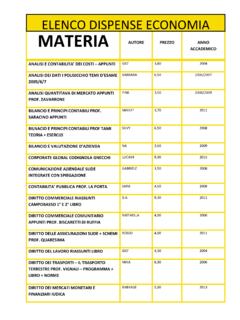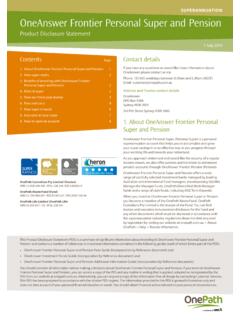Transcription of Solution Focused Therapy
1 Solution Focused Therapy treatment manual for Working with Individuals 2nd Version* . Solution Focused Brief Therapy Association July 1, 2013. Contributors Janet Bavelas Peter De Jong Cynthia Franklin Adam Froerer Wallace Gingerich Johnny Kim Harry Korman Stephen Langer Mo Yee Lee Eric E. McCollum Sara Smock Jordan Terry S. Trepper _____. * This document will continually be revised to reflect updates in clinical practice and research relevant to SFBT. Copyright 2013 SFBTA. 2. overview , DESCRIPTION, AND RATIONALE. The purpose of this Preliminary treatment manual is to offer an overview of the general structure of Solution - Focused Brief Therapy (SFBT). This manual will follow the standardized format and include each of the components recommended by Carroll and Nuro (1997).
2 The following sections are included: (a) overview , description and rationale of SFBT; (b) goals and goal setting in SFBT; (c) how SFBT is contrasted with other treatments; (d) specific active ingredients and therapist behaviors in SFBT; (e). nature of the client-therapist relationship in SFBT; (f) format; (g) session format and content; (g) compatibility with adjunctive therapies; (h) target population; (i) meeting needs of special populations; (j) therapist characteristics and requirements; (j) therapist training; and (k) supervision. Solution - Focused Brief Therapy is based on over twenty-five years of theoretical development, clinical practice, and empirical research ( , de Shazer et al.)
3 ,1986;. Berg & Miller, 1992; Berg, 1994; De Jong & Berg, 2008; de Shazer, et al., 2007). Solution - Focused Brief Therapy is different in many ways from traditional approaches to treatment . It is a competency-based and resource-based model, which minimizes emphasis on past failings and problems, and instead focuses on clients' strengths, and previous and future successes. There is a focus on working from the client's understanding of her/his concern/situation and what the client might want different. The basic tenets that inform Solution - Focused Brief Therapy are as follows: It is based on Solution -building rather than problem-solving. The therapeutic focus should be on the client's desired future rather than on past problems or current conflicts.
4 Clients are encouraged to increase the frequency of current useful behaviors. No problem happens all the time. There are exceptions that is, times when the problem could have happened but didn't that can be used by the client and therapist to co-construct solutions . Therapists help clients find alternatives to current undesired patterns of behavior, cognition, and interaction that are within the clients' repertoire or can be co- constructed by therapists and clients as such. Differing from skill building and behavior Therapy interventions, the model assumes that Solution behaviors already exist for clients. It is asserted that small increments of change lead to large increments of change. Clients' solutions are not necessarily directly related to any identified problem by either the client or the therapist.
5 The conversational skills required of the therapist to invite the client to build solutions are different from those needed to diagnose and treat client problems. 3. EVIDENCE BASE OF Solution - Focused BRIEF Therapy . SFBT has been recognized as an evidence-based practice and appears on the Substance Abuse Mental Health Services Administration's National Registry of Evidence-Based Programs and Practices ( ) and the Office of Juvenile Justice and Delinquency Prevention Model Programs Guide ( ). There is also a growing body of outcome studies using more rigorous experimental designs that demonstrate the effectiveness of SFBT. (Franklin, Trepper, Gingerich, & McCollum, 2012). Within quantitative research, a meta- analysis study of a particular intervention is viewed as the strongest evidence supporting the intervention's effectiveness followed by experimental design studies (Fraser, Richman, Galinsky, & Day, 2009).
6 Two independent meta-analyses of SFBT. have been conducted, one by a team of Dutch researchers (Stams, Dekovic, Buist, &. De Vries, 2006) and one by a United States social work academic researcher (Kim, 2008). The Stams et al. (2006) meta-analysis involved 21 studies involving 1,421. participants and found an overall effect size estimate of , which is considered small to near medium treatment effect favoring SFBT. The second meta-analysis by Kim (2008) analyzed treatment effects of SFBT for externalizing behavior, internalizing behavior, and family or relationship problems. Overall 22 studies were included in Kim's meta-analysis with effect size estimates ranging in the small range ( ) for all three outcomes.
7 Results from these systematic reviews, along with other experimental design studies noted in Appendix A, show SFBT to have small to medium positive treatment effects. In addition to the meta-analysis completed by (Stams, 2006 &. Kim, 2008)], Gingerich & Peterson (2013) conducted a qualitative review of 43. controlled outcome studies on SFBT and concluded that SFBT is an effective approach with many different psychosocial conditions with children/adolescents and adults. Evidence from the studies reviewed further indicated that SFBT is especially efficacious for adults with depression. See Appendix A for a table of outcome studies on SFBT. In addition to outcome studies (randomized controlled trials) that support the effectiveness of SFBT practice ( , Kim, Smock, Trepper, McCollum, & Franklin, 2010), there is both theoretical and empirical support for SFBT process.
8 The theory of co-construction that is basic to the SFBT therapeutic process comes from a theoretical tradition that spans several disciplines including sociology, psychology and communication studies ( , Berger & Luckmann, 1966; de Shazer, 1994; Gergen, 2009; McNamee & Gergen, 1992). The use of language and the co-construction process are integral to the SFBT change process and will be described in more detail below. The empirical details of the SFBT approach to language use in dialogue have a solid experimental basis in contemporary psycholinguistic research ( , review in Bavelas, 2012). Finally, there is recent and ongoing original research on the specific dialogic processes by which co-construction happens both in SFBT versus in contrasting therapies ( , Phillips 1998, 1999; McGee 1999; McGee, Del Vento, &.)
9 Bavelas, 2005; Tomori, 2004; Tomori & Bavelas, 2007; Korman, Bavelas, & De Jong, in press; Smock Jordan, Froerer, & Bavelas, in press; Froerer & Smock Jordan, in press). Additionally, there is additional change process research that shows that the therapeutic 4. techniques used in SFBT may have positive affects on client change. For example, therapeutic processes such as pre-suppositional questions, Solution talk, and engendering hope and positive expectations in clients toward change increased positive results in client goals. Techniques such as the scaling question and miracle question have also been shown to accomplish their intended purposes in Therapy sessions (McKeel, 2012). See Appendix B for a review of the research that shows how Co- Construction works in SFBT process.
10 Solution - Focused THERAPEUTIC PROCESS. Psychotherapeutic process is defined as Whatever occurs between and within the client and psychotherapist during the course of psychotherapy. This includes the experiences, attitudes, emotions, and behavior of both client and therapist, as well as the dynamic, or interaction, between them (Vandebos, 2007, p. 757). The SFBT approach to the therapeutic process is unique in at least three ways. First, other approaches to process focus primarily on what happens within the client. For example, when defining mechanisms of change in psychotherapy, Nock (2007, p. 8S). included only psychological or biological processes and explicitly excluded the communication between the therapist and client.
















